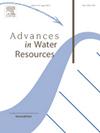An extended two-parameter mixed-dimensional model of fractured porous media incorporating entrance flow and boundary-layer transition effects
IF 4.2
2区 环境科学与生态学
Q1 WATER RESOURCES
引用次数: 0
Abstract
We develop an enhanced reduced model for single-phase flow in fractured porous media capable of incorporating more realistic interface conditions at the fracture terminations. In addition to the traditional dimensional model reduction, where the elements of the discrete fracture network are treated as lower dimensional manifolds embedded in the porous matrix, we explore the microscale behavior of the boundary layer flow at the entrances of a fracture bounded by two parallel plates to construct a new set of interface conditions of Robin-type, giving rise to localized pressure jumps at the fracture edges. Within this enriched description, sharper reduced flow and tracer transport mixed-dimensional models are constructed in the asymptotic limit ruled by two small parameters related to the ratio between fracture aperture and entrance developing length and a macroscopic length scale. The discrete flow/transport mixed-dimensional model is discretized by a new discontinuous Galerkin(dG)-based formulation. An adequate version of the Galerkin-Newton method is developed for the numerical treatment of the non-linear Robin interface condition. Considering several fracture arrangements, numerical results illustrate the sharper description of the model proposed herein in predicting flow and tracer transport patterns in fractured media.
包含入口流和边界层过渡效应的断裂多孔介质扩展二参数混合维模型
我们为断裂多孔介质中的单相流建立了一个增强的简化模型,该模型能够在断裂终端纳入更真实的界面条件。除了将离散断裂网络的元素视为嵌入多孔基质中的低维流形的传统降维模型外,我们还探索了由两块平行板围成的断裂入口处边界层流动的微观行为,构建了一套新的罗宾型界面条件,从而在断裂边缘产生局部压力跃迁。在这一丰富的描述中,在渐近极限中构建了更锐利的还原流动和示踪剂传输混合维度模型,该模型由两个与断裂孔径和入口发育长度比值有关的小参数和一个宏观长度尺度所控制。离散流动/传输混合维度模型通过一种新的基于非连续伽勒金(dG)的公式进行离散化。为对非线性罗宾界面条件进行数值处理,开发了一种适当版本的 Galerkin-Newton 方法。考虑到几种断裂布置,数值结果表明本文提出的模型在预测断裂介质中的流动和示踪剂传输模式方面具有更清晰的描述。
本文章由计算机程序翻译,如有差异,请以英文原文为准。
求助全文
约1分钟内获得全文
求助全文
来源期刊

Advances in Water Resources
环境科学-水资源
CiteScore
9.40
自引率
6.40%
发文量
171
审稿时长
36 days
期刊介绍:
Advances in Water Resources provides a forum for the presentation of fundamental scientific advances in the understanding of water resources systems. The scope of Advances in Water Resources includes any combination of theoretical, computational, and experimental approaches used to advance fundamental understanding of surface or subsurface water resources systems or the interaction of these systems with the atmosphere, geosphere, biosphere, and human societies. Manuscripts involving case studies that do not attempt to reach broader conclusions, research on engineering design, applied hydraulics, or water quality and treatment, as well as applications of existing knowledge that do not advance fundamental understanding of hydrological processes, are not appropriate for Advances in Water Resources.
Examples of appropriate topical areas that will be considered include the following:
• Surface and subsurface hydrology
• Hydrometeorology
• Environmental fluid dynamics
• Ecohydrology and ecohydrodynamics
• Multiphase transport phenomena in porous media
• Fluid flow and species transport and reaction processes
 求助内容:
求助内容: 应助结果提醒方式:
应助结果提醒方式:


